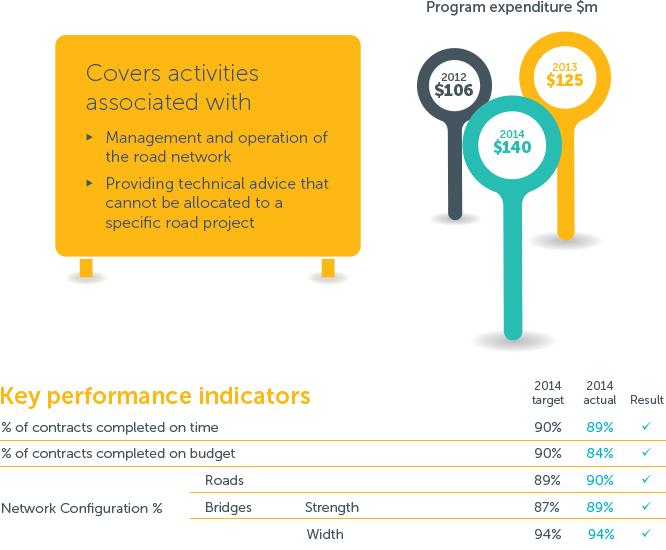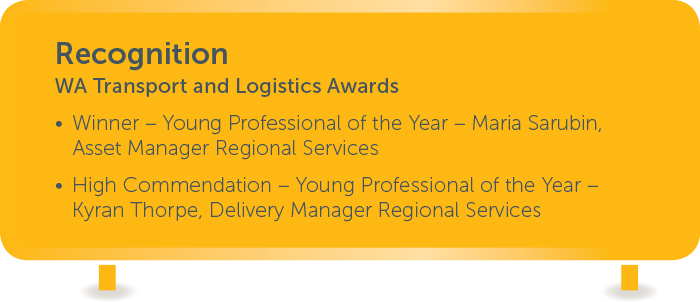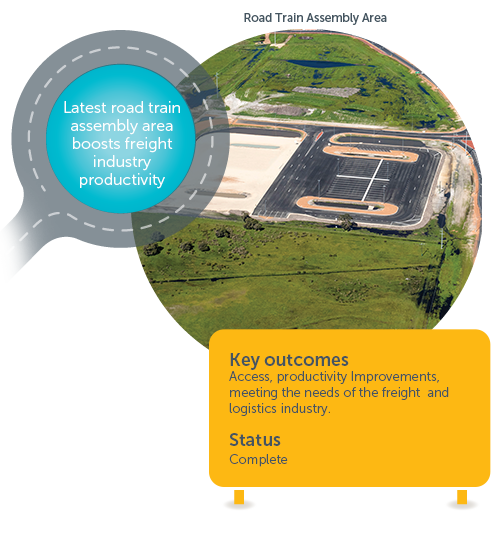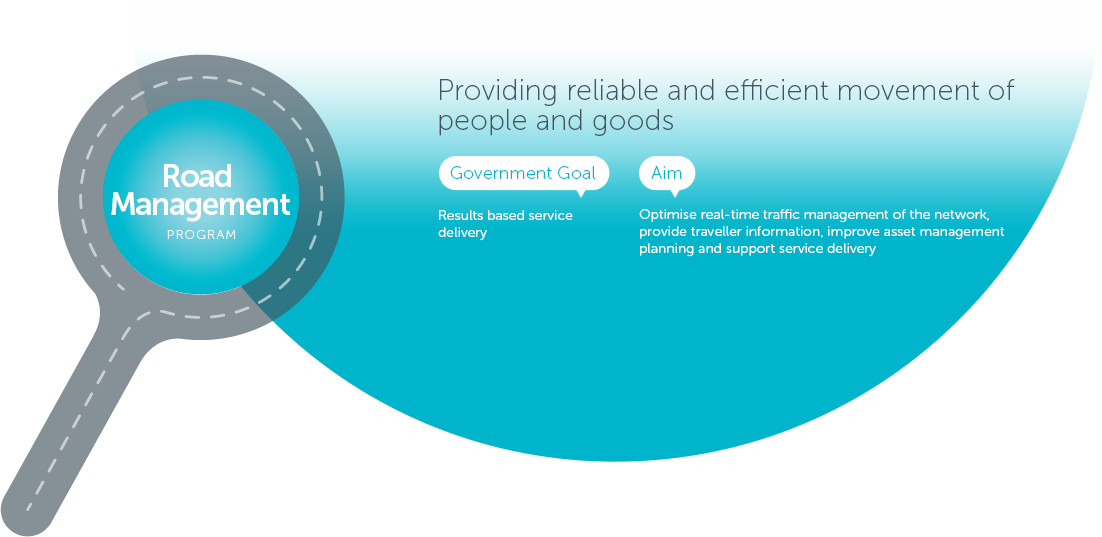
 The Program includes activities of our:
The Program includes activities of our:
- Traffic Operations Centre
- Road Safety Support
- Heavy Vehicle Services Planning and
- Technical Services
Traffic Operations Achievements
Our Traffic Operations Centre (TOC) is responsible for monitoring and managing the Perth Metropolitan road network and is the central contact point for real time traffic information across the state.
We use Intelligent Transport Systems devices such as Variable Message Signs and Closed Circuit Television Cameras (CCTV) to ensure the efficiency of the road network during peak commuter travel times, special events and unplanned incidents.
The numbers:
We coordinate and manage:
- 940 sets of traffic signals
- 273 CCTV cameras
- 65 cameras in the Northbridge tunnel
- 24 web dedicated cameras
- 25 Variable Message Signs
Incident Response Service
Our Incident Response Service (IRS) deploys specially trained, mobile road crews on Perth’s freeways and CBD roads to provide quick clearance solutions and traffic control for road hazards such as breakdowns, crashes and spillages helping to restore normal traffic conditions as quickly as possible.
Over the past year the IRS have responded to a total of 1650 call-outs including 326 breakdowns and 324 debris removals.
For further information about the service visit our website.
Road Safety Support Achievements
A range of detailed Road Safety procedures have been developed and other forms and policies have been updated to provide improved support and coordination across the State. These, along with a range of policies, guidelines and safety tools that may be of use to practitioners and the community are available on our website.
Crash Investigations
The numbers:
Over the past year:
- 127 preliminary fatal crash investigations undertaken.
- 27 comprehensive full reports completed.
- 53 preliminary investigations of serious casualty crashes undertaken.
- 5 full reports completed .
Our Crash investigation Policy and Application guidelines have been reviewed and now include Close Out for actions and court appearances. Administration Guidelines are also under development which will improve knowledge and uniformity of reporting across Main Roads.
Traffic Management
A number of initiatives were rolled out during the year to improve the standard of traffic management across the State. One such initiative was an internal educational presentation developed and delivered to our regional offices. The presentation was designed to increase knowledge of the Traffic Management Code of Practice and other traffic management initiatives and requirements.
We have also developed a nationally recognised course in Truck/Trailer-Mounted Attenuator (TMA) Operation.
TMAs are the truck mounted energy absorbing devices which are positioned behind road work crews to protect them from collisions by out of control vehicles.
This course will help provide industry with the knowledge and skills to operate TMAs on public roads as part of a traffic management road crew, improving the safety of both road workers and road users.
Exercise “Eastern-Portal”
In mid-2013 Main Roads led a multi-agency tactical desktop exercise comprised of representatives from WA Police, Fire and Emergency Services, St John Ambulance, Lend Lease and our operational and executive staff.
Participants were given a rare opportunity to learn from the experiences of key note speaker Superintendent Glen Weir from Victoria Police who was involved in the 2007 Burnley Tunnel Disaster.
The aim of the exercise was to test Main Roads preparedness in the event of a major incident in the Northbridge Tunnel as we converted to its new three lane configuration.
The Scenario Directing staff created the exercise in real-time and focused on features unique to our Tunnel including access and egress options, casualty scenarios and best practice recovery efforts. The setup of effective traffic management was a key element of the exercise with a focus on minimising the impact to the surrounding road network whilst safeguarding the emergency response performance.
A post exercise analysis led to a number of key recommendations aimed at improving processes across all areas concerning incident management, resulting in improved interagency communications and new systems training for Lend Lease staff.
Heavy Vehicles Achievements
In recognition of the crucial role played by the freight and logistics industry in supporting and encouraging the WA economy, Heavy Vehicle Services (HVS) was established as a separate directorate within Main Roads in 2014.
Vehicles over 19m long, 4.3m high, 2.5m wide or over 42.5 tonnes gross mass are classed as Restricted Access Vehicles (RAVs). Heavy Vehicle Services (HVS) regulates RAV access to the States road network via a system of notices and permits. HVS is at the forefront of developing and implementing measures aimed at improving efficiency, road safety, community amenity and the preservation of road infrastructure.
The following are some of the initiatives progressed by HVS over the past 12 months.
Over-Size, Over-Mass Unit
The Over-Size, Over-Mass (OSOM) Unit provides the heavy vehicle industry with a centralised point of contact to process permit applications and approvals required to conduct over-size, over-mass movements. Designed around the needs of industry, the Unit facilitates approvals for a wide variety and volume of OSOM movements, providing industry with the confidence to commit to planned ventures, securing jobs and supporting the growth of the Western Australian economy.
The Unit’s cost-recovery business model provides operators with fiscal certainty and the ability to budget effectively, as well as relieving taxpayers of the requirement to underwrite services provided to commercial industry.
The OSOM Unit has been providing far-reaching benefits by:
- Centralising the process of obtaining an over-size load permit, booking a traffic escort and obtaining referral to power utilities for power line clearance
- Providing traffic escort wardens who are flexibly deployed according to demand
- Providing industry with a single point of contact for heavy vehicle enquiries, extended hours of service and first point of contact issue resolution through the creation of the Heavy Vehicle Helpdesk (138 HVO)
- Undergrounding overhead power lines, removing the need for line-lifting services to accommodate high loads.
Heavy Vehicle Safety Program
The number of incidents involving heavy vehicles has brought into focus a need to develop further heavy vehicle road safety initiatives.
In response, we have identified a three tier Heavy Vehicle Safety Program aimed at contributing towards the State’s Towards Zero strategy.
These are:
- Public Awareness – Improving the understanding on the general motoring public when interacting with heavy vehicles on the road network. A postcard campaign aimed at the general road users reinforced the need to adopt safe driving behaviours when interacting with heavy vehicles was undertaken in 2013 to kick off the program.
- Compliance –Increasing the number of targeting roadblocks and conducting information sessions regarding the Chain of Responsibility (CoR) legislation and fatigue.
- Industry Education, Research and Technology – Undertaking industry research and investigating emerging technologies that address driver/operator safety issues.
Compliance
We are responsible for monitoring and improving heavy vehicle compliance outcomes of road safety and infrastructure protection, minimising the impact of road transport on the community, and reducing unfair competitive advantage through non-compliance. In line with our responsibility, our Transport Inspectors provided support to WA Police for Austrans, the national heavy vehicle enforcement campaign, which took place throughout Western Australia from 12 May to 8 June 2014.
This multi-jurisdictional approach by enforcement agencies included Worksafe, Comcare Department of Mines and Petroleum, Transport and Fisheries to target heavy vehicles for road breaches including, mass, dimension, load restraint, permit breaches, speeding, unroadworthy vehicles and unlicensed drivers, vehicles and drug or drink driving offences.
Industry Reform
We participate in various national reform initiatives which will play a major role in shaping the transport industry of the future. These include:
Performance Based Standards (PBS) – The standards will focus on how well a vehicle behaves on the road, rather than focussing purely on their length or mass. It allows industry additional opportunities to innovate, resulting in improved productivity for a given freight task, safer performance and the least possible effects on roads and bridges.
Intelligent Access Program (IAP) – The program will promote a move towards self-regulation, giving operators’ enhanced access to the road network in return for the monitoring of their compliance with access conditions using in-vehicle communications technology.
Pilot Accreditation
Regulatory arrangements for the accreditation of pilots is currently split across three government agencies and training providers. This fragmented multi-agency approach causes confusion to Pilots and the broader transport industry and community. We are working towards becoming the sole agency responsible for a new pilot accreditation scheme, which will include a regulatory framework to incorporate all relevant legislation, regulations and administrative requirements for pilots in Western Australia. The new scheme will endeavour to reduce the regulatory and administrative red tape that currently exists with the multi-agency system.
Harvest Mass Management Scheme
A Harvest Mass Management Scheme (HMMS) has operated in Western Australia since the 2009 harvest season to provide flexibility in the movement of grain direct from paddock to receival facilities. The scheme was developed to encourage transport operators to load grain to normal levels, but allows an extra mass concession of up to 10% to cater for the variability of loading. The HMMS was initially operated on a trial basis with post-harvest performance reviews, which resulted in refinements being made to the business rules to discourage some loading practices not in accord with the intent of the scheme. As an outcome of the review, the Minister approved the permanent adoption of the HMMS. The annual review of loading data following the 2013 harvest has confirmed the State’s farming community’s strong support for the scheme, with continuing high levels of compliance.
Accredited Mass Management Scheme
We are at the forefront of developing an extra mass management scheme, replacing the existing 20-year-old framework which is in need of reform.
Recommended by the Ministerial Heavy Vehicle Advisory Panel, the new Accredited Mass Management Scheme (AMMS) will be rolled out in two stages. Stage One involves the amalgamation of the Certified Mass Management Scheme and the Concessional Loading Bulk Products Scheme and development of a new Accreditation Module. Stage Two will consolidate and include more industry-specific mass schemes, including the Livestock Concessional Loading Scheme and the Import and Export Container Scheme.
Underpinning the proposed arrangements will be a new Mass Management module aligned with WA Heavy Vehicle Accreditation (WAHVA). Currently, WAHVA comprises maintenance and fatigue management modules. Prescribing standards for ensuring and demonstrating compliance with mass and loading requirements are included in the provisions of the Road Traffic (Vehicles) Act 2012.
Planning and Technical Achievements
Bridge Management System (BMS)
The creation of the innovative Bridge Management System (BMS) signals a significant improvement in the way we manage and maintain road bridges.
First released in September 2011, the BMS is made up of a series of modules that assist our Regions and bridge staff to undertake asset management in an more effective, efficient and transparent manner.
The work undertaken in enhancing the system over the last twelve months included:
- Completion of a Program Management Module
- Upgraded Bridge Enquiry Module
- Photo management
- Improvements in the Heavy Vehicles Module
NorthLink
The Perth-Darwin National Highway (PDNH) is an important national route connecting Perth with the north west of Western Australia and the Northern Territory. In the coming years, urban growth and other developments in the north east corridor of the Perth metropolitan area and beyond is forecast to increase traffic congestion and reduce social amenity and the serviceability of the existing national highway route. As a result, the need to plan for a new road between Reid Highway and Muchea was identified and detailed planning was initiated in the late 1990s.
We recently completed the planning for a key section of the PDNH, previously referred to as the Swan Valley Bypass and more recently as NorthLink. Planning was undertaken in two sections which included:
- The Northern Section (Maralla Road Bullsbrook to Muchea) – This involved an alignment definition planning study, development of a preferred ultimate planning design concept and definition of an associated reservation in consultation with key stakeholders. Since the completion of the planning study, we have provided technical support for the Metropolitan Region Scheme (MRS) amendment process to include the required road reservation for this section of the highway
- The Southern Section (Reid Highway to Maralla Road) –A strategic road network review was completed. It concluded that a more direct connection of the PDNH with Tonkin Highway would provide significant benefits. Following the review, a major alignment definition planning study devised an ultimate planning design concept and defined the reservation.
More information about NorthLink can be found on our website.
New Multi-Modal transport model – ROM24.
Transportation decision-makers often confront difficult questions and must make informed choices. How will our regional and local transportation system perform 30 years into the future? What policies or investments could influence this performance?
Strategic transport models support decision-making by forecasting how a city’s travel demand will adjust in response to land use changes, investments in network infrastructure or policy decisions.
ROM24 is the latest development to the strategic transport model known as ROM which has operated since the 1970s. Major enhancements incorporated into ROM24 include:
- Mode choice modelling providing a new capability to model travel demand share across the five major transport modes: car driver, car passenger, walking, cycling and public transport.
- Improved traffic assignment that incorporates an innovative traffic assignment algorithm to more accurately model the impact of congestion on our road network
- True shape networks that integrate with our GIS systems to provide a true shape representation of our road network
These enhancements will significantly improve our modelling capability to help us forecast performance and demand to guide our decision making in the future.
Innovative Ramp Solutions
Traversing the busy Graham Farmer Freeway can sometimes prove challenging for even the most experienced driver. To make the journey safer and easier for road users, we designed and constructed an innovative ramp arrangement involving a new on-ramp from the Northbridge tunnel to the northbound Mitchell Freeway.
The new ramp arrangement enables exiting traffic to be in the left-hand lane resulting in the ability to avoid a dangerous and disruptive weave across multiple lanes of traffic. During the afternoon peak period approximately 25% of traffic exiting the Graham Farmer Freeway utilises either the Vincent Street or Powis Street exits.
The lateral thinking, low-cost innovation has led to a number of benefits for motorists including:
- Simplified exiting – eliminating the weave between the Graham Farmer Freeway entry to Mitchell Freeway and the Vincent Street exit. Vehicles no longer need to “force” their way across multiple lanes of traffic.
- Improved safety – by eliminating the need to change lanes, the potential for side-swipe and rear end crashes is significantly reduced
Looking Ahead
- Develop a process to identify the most suitable intersection treatment to use during road projects.
- Trial the use of telematics technology to monitor and enhance heavy vehicle access to the State’s road network.
- Implement an internationally recognised Road Safety Management system to ensure optimal road safety outcomes are achieved.
- Investigate the possible implementation of All Lane Running on Kwinana Freeway northbound from Canning Highway to Narrows Bridge.
- Trial the use of pedestrian countdown timers at traffic signals (PCaTS). For further information about the trial, visit our website.
- Develop an effective timing review and auditing programme for traffic signals to relieve congestion.
Regulating access to WA’s road network for Restricted Access Vehicles (RAVs) requires striking a balance between the development and maintenance of RAV networks, road safety, infrastructure protection and the productivity of the transport industry. Read More

Suitable Road Train Assembly Areas (RTAAs) are provided at the end points of RAV networks, to enable transport operators to break-down their vehicle combinations to an appropriate dimension in order to continue travelling on the public road network. Without an RTAA in a strategic location, transport operators without access to a local depot would need to break-down their vehicle combinations on the road side, posing safety issues for them and other road users.
In mid-2014, we opened our latest Road Train Assembly Area on Willinge Drive, Picton, approximately 420 metres north of the Bunbury Outer Ring Road roundabout.
The works involved the construction of 20 road train assembly bays, access and circulating roads, miscellaneous parking, lighting and fencing. The new RTAA enables the 36.5 metre road train network to be extended to allow these vehicle combinations to enter and exit the Greater Bunbury area.
Access to vehicles up to 36.5m in length is now available from Perth to the new RTAA via Roe Highway, Kwinana Freeway and Forrest Highway. All roads in the Bunbury Region with interim 36.5m access have been added to the appropriate RAV network.
The Bunbury RTAA was jointly funded by the Commonwealth and State on an 80:20 basis using some project savings from the recently joint funded Bunbury Port Access Project.


